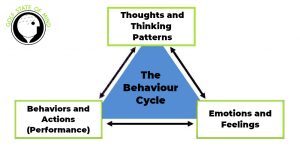
Controlling Emotions in Golf
Controlling Emotions in Golf with Self Awareness or “Mindfulness”
“Being your best means creating a space between stimulus and response, and in that space you have the freedom and power to choose a response that is in alignment with your values and goals.” – George Mumford
Part of doing the “Inner Work” for golf is reflecting on your rounds and identifying the events that can trigger the thoughts, feelings and emotions which hold you back. Once you’ve done this, you will know what to look out for on the course. Noticing your thoughts, feelings and emotions will help in your controlling emotions in golf, rather than them controlling you.
The key word in the previous sentence is “noticing” and this is what Self Awareness or “Mindfulness” is all about.
To illustrate this, let’s take look at the behaviour cycle:
 As you can see above, emotions, thoughts and behaviors are all connected in a loop. Without noticing, the loop just continues, i.e., emotions create feelings, which trigger thoughts, which increases the potency of emotions which changes our mood and “performance state”. Remember that one of the main goals of improving your mental game of golf is being able to upwardly maneuver between performance states. The first step in this process is mindfulness. This is an especially valuable skill in golf. In most other sports, the game happens faster so there’s less time to be influenced by your emotions and thinking (engagement in the game keeps your mind focused on the present). But in golf, for most of the time you’re “playing”, you’re in between shots with plenty of time to let your emotions and thoughts around them interfere and affect how you play.
As you can see above, emotions, thoughts and behaviors are all connected in a loop. Without noticing, the loop just continues, i.e., emotions create feelings, which trigger thoughts, which increases the potency of emotions which changes our mood and “performance state”. Remember that one of the main goals of improving your mental game of golf is being able to upwardly maneuver between performance states. The first step in this process is mindfulness. This is an especially valuable skill in golf. In most other sports, the game happens faster so there’s less time to be influenced by your emotions and thinking (engagement in the game keeps your mind focused on the present). But in golf, for most of the time you’re “playing”, you’re in between shots with plenty of time to let your emotions and thoughts around them interfere and affect how you play.
The practice of mindfulness, allows us to:
• Acknowledge certain thoughts, feelings and emotions, without letting them affect us or identifying with them.
• redirect focus to how you want to be (your values and intentions)
• turn the volume down on “mental chatter”
• be more accepting of what we are experiencing, so we can be more agile in how we navigate challenges
Using Mindfulness to Regulate Emotion and Choose How You Would like to Respond
“Focus, notice and redirect” – Dr. Amishi Jha, author of Peak Mind
As we go about our days, emotions are being triggered subconsciously by our environment (events, people, our senses, etc.), or by our own thoughts and memories. Feelings are the physical sensations of those emotions. A feeling is the first thing we are able to notice about how something has affected us, emotionally. We can learn a lot about ourselves by recognizing our feelings.
If we don’t recognize our feelings, unregulated “negative” emotions can cause negative thinking, negative self talk which can make controlling emotions in golf more challenging. However, if we can notice feelings, we can reduce the flow of that energy, before it triggers thoughts that make the emotion bigger.
Most of the 70,000 or so thoughts that we have each day are responses to the emotions that we feel, and many times, because of the negativity bias, these thoughts are negative (it’s the brain’s survival mechanism at work). We can easily create a story around a feeling, without being aware of it.
Here are some examples:
Feeling Negative Thought
Feeling of anxiety over a 4 ft putt Don’t miss this putt
Feeling of frustration after missing a putt You are bad at short putts
Feeling of anger after hitting a hitting tee shot O.B. This is going to mess up my score
How to Control Emotions in Golf
Zen master, Thich Nhat Hahn, said that the first step to being more mindful is acknowledging how you feel. I.e. you say to yourself “I feel ______”, such as “I feel nervous”, or “I feel angry”. This is an act of acceptance and self-compassion. It’s ok to experience a feeling or a thought and not try to change them. Feelings are temporary, not permanent. If you don’t notice them or you resist them (by telling yourself that you shouldn’t feel that way), you give them power over you. By noticing and accepting them, you distance yourself from them and allow them to pass and dissipate.
Step 1: Acknowledge: What am I thinking and how am I feeling now? Be curious instead of judgmental =>
Step 2: Accept: “I’m thinking____ and feeling_____, and that’s ok.
Step: 3: Where do I feel that emotion?
Step 4: Reset by bringing yourself back to the present by focusing on your breathing, smiling, or a say a positive affirmation.
The more you go through this process, the more mindful you become, the better you will do at controlling emotions in golf and choosing a response that is inline with your values and intentions.

